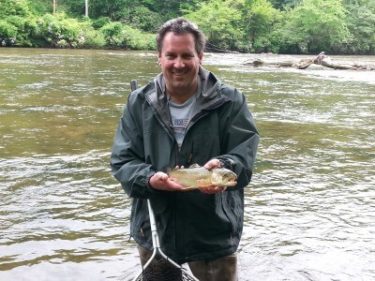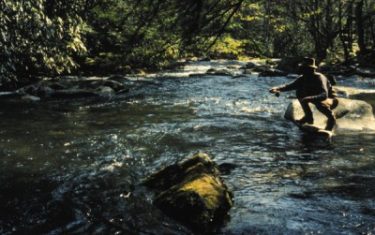.Creel Study for Upper Nantahala River
The North Carolina Wildlife Resource Commission, (NCWRC), conducted a creel study on the Upper Nantahala River in October of 1993 The creel study for Upper Nantahala River yielded some very interesting results as to why instruction is such a necessity for anglers that wish to improve. The Delayed Harvest section of the Upper Nantahala is located about 30 minutes from Bryson City, NC.
Bryson City, NC is nestled in the Great Smoky Mountains and is the trout mecca for the region. The NCWRC maintained catch ratios through personal surveys and the results were astounding! There have been similar studies done by other fish and wildlife agencies in other states and they conclude very similar results to this one.

Donut Pie Chart Illustrates 2.6% (outer ring) Catches Over 1/3 Total Numbers (inner ring)
Creel Survey Data
Their study illustrates that .003% of the total surveyed caught 12.4 trout per hour (TPH) while the other 99.007% caught an average of .81 TPH. The top 2.6% of the anglers surveyed caught 8 TPH while the rest of the surveyed group catches one fish every 76 minutes.
In other words, the 2.6% has a trout landed every 7 minutes while others wait 76 minutes for each and every hookup. Keep in mind that this is not the growth season for trout in this region so just imagine what the results could be in the springtime! The fascinating part of this study reveals that the top 2.6% of the entire population surveyed caught over a third of the total trout landed during the eight-week study.
Fly Fishing Lessons & Instruction
This study is not intended to discourage anglers. There are steps involved in becoming more successful over time. These types of studies are beneficial to anglers for improvements to take place. How many similar studies have you read recently? It is rare indeed because the lure of angling is always to perceive you will be successful on each and every cast if you only had that new rod, that ‘magic fly’, or whatever ‘hot tip’ cookie-cutter approach the media offers. creel study upper nantahala
Optimism is an essential ingredient for the successful angler but there are stages of progression one must be willing to undertake to reach this level of consistent results. American society is so very into instant gratification that few seem willing to work for perfection.
Fly fishing is an art form that takes many years for one to attain consistent results. It requires one to fish often in many different environments and conditions. A basic understanding of mechanics will open up huge gains for solving problems with your casting as they arise on the stream.
Many simply get tired of angling on wild trout waters simply because they tend to be more difficult than their hatchery brethren cousins. This is no doubt why the Delayed Harvest and privately stocked waters tend to be so popular.
Trout Fishing is Problem Solving
When anglers fish wild waters they often tend to criticize the fishery. We all hear comments like the ‘baiters’ have cleaned it out. Someone fished in front of me. If I only had that new submarine technological rod. If I just had the magic fly. The list can get lofty in short order! These anglers often spend their time on hatchery supported water, private waters stocked heavily, or other non-challenging waters.

These types of examples provide excellent learning curves for beginner anglers because trout tend to cooperate. One should seek more remote and wild waters as their skill level progresses. It takes a serious commitment for anglers of all levels of skills to ‘push the envelope’ to attain the next level. This means learning fundamentals properly in the first place, practicing these fundamentals on land until you are confident in your abilities, angling on many different types of waters, and to fish often enough to fine-tune these skills. creel study upper nantahala
There is Pixie Dust Trout Fishing?
Following the delusions of the magical “honey hole”, pixie dust, and that special unique fly that you just threw into the tree will rarely improve your skill. They are simply excuses for folks very new to the sport. Fly fishing for trout at a high level requires some serious work on the stream. There is no substitute for the hard work along with your personal journey. We are blessed to spend so many days of every year on some great water.
We want to teach folks that wish to learn about this art form and are not satisfied with dabbling with mediocrity! Those types of folks will look and fish the same all of their life with little to no improvement. What I really enjoyed about the NCWRC study is that it helps to prove what we already knew for years. A few percents of the anglers catch most of the numbers of trout!
Keys for Skills to Increase Trout Fishing
Is it simply luck that the top 2.6% of the angling community always seem to have high ratios of trout landed on each and every outing? These elite few anglers always do well because they have learned the keys for skills to increase trout fishing. The majority of anglers could stand for improvement in water reading skills and develop the ability to pilot the rod to gain greater control of the entire drift. Sure there are numerous other important considerations to understand but what I am saying is the majority (90% or more) of the angling community could all stand much improvement for their casting and reading water abilities.
Long drag-free floats in productive feed lanes rarely happen by accident. Repetition of applying the fundamentals in a logical manner increase LEARNING. Everything on the water basically boils down to your efficiency in which you perform the task of reading water, casting skills, line control, stealth tactics, fly selection, and your cumulative knowledge of everything you know about the watery elements and their inhabitants.
A few very basic fundamentals often can increase anglers’ float times by as much as 600%. Dragging fly patterns actually spook your older and more experienced fish-the really big ones. False casting too much is a sure method to spook trout into the next state. It is also simple statistics that if your fly was in the air most of the day then how can you expect many trout landed? False casting should be one backcast followed by delivery each and every time on the water. This requires the angler to thoroughly understand the dynamics behind the cast.
Learn to Get A Drift!
Learn to get a drift with a long float time for the entire feed lane before you cast again. Very few anglers have this ability simply because they never developed it in the first place. It helps to master this much quicker by first learning a few basic principles of moving water. Secondly, gain control over the cast to the point that you rarely cast straight. Mastering the cast is simply learning the game of angles and having the ability to alter your cast.
The majority of the time we use 90° angles more than a straight line cast because it gets results! This improvement can be thought of as numbers of trout hooked up and landed. As opposed to a few fish caught, many spooked, and a sore arm from working too hard during the cast.
A day of private instruction with a professional guide can transform your basic skills. It is the best dollar you will spend on the sport! They show up expecting the destination and miss the journey entirely about what fly fishing encompasses. That, in my opinion, is what the masses seem to miss most of all about this great sport! Good days measured in numbers of fish landed varies from one angler to the other.
Fly Fishing Lessons and Instruction
Keep in mind that there are literally hundreds of programs that offer fly fishing lessons and instruction. Good instruction means you come away knowing what skills to improve! Most guides tie knots, make lunch, and row a boat. How does this improve you for the next time you go to the river?
Many have not mastered getting a “drag-free” drift still, hence how can they teach others? Most of these institutions preach straight-line casting methods, reach cast, and basic mend. This is far short of what is necessary to master great presentations. A great instructor must have the ability and a method that conveys this in a logical manner.
Quality Instruction Is the Best Investment
Seek out quality instruction for your journey. The guide describes the exact location for the student to cast and tells when to strike. They may offer tips on playing and landing fish, and much more to name a few.
The instructor should be able to mimic the mistake for the student and suggest the correct fix. Provide you with a solid fly casting foundation. There are numerous other important concepts for mastering better presentations.
If you never learned the ‘art of angles’, then a quality lesson from an experienced instructor is a wise choice. There are numerous misconceptions surrounding this wonderful sport. The successful angler learns to understand the quarry thoroughly and develops predator like skills. The equipment lets you perform at your best after you first develop an awareness of how to use it properly. Do you wish to learn the art of fly fishing with techniques that get consistent results? We love to teach skills for your journey of what this entails in the great sport of fly fishing.

